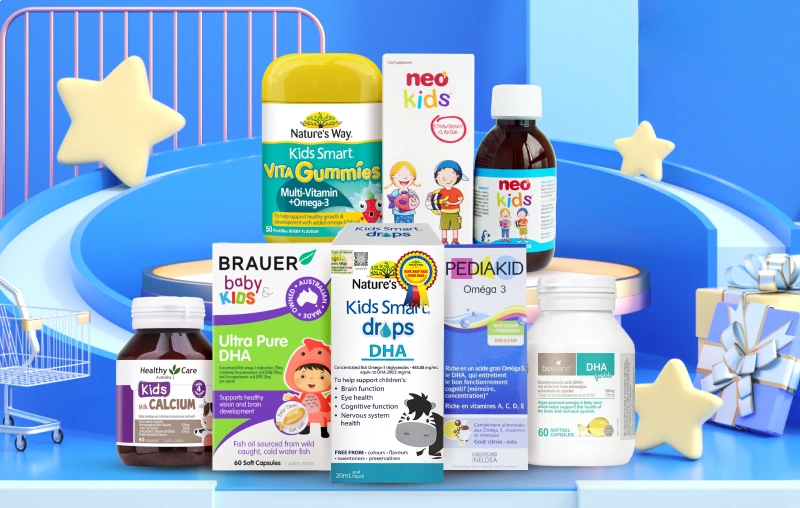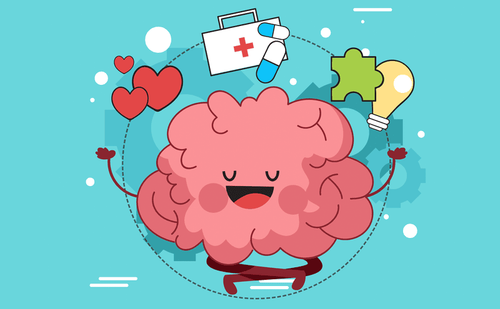In a child’s journey of growth, providing adequate nutrients plays a pivotal role, especially for the development of their brain and vision. Among these, DHA (Docosahexaenoic Acid) emerges as an indispensable “super-nutrient.” So, what is DHA, why is it so crucial for children, and how can it be supplemented correctly? This article will provide a comprehensive overview of DHA, helping parents build a strong foundation for their child’s bright future.
What is DHA? The Power of an Omega-3 Fatty Acid
DHA is a long-chain polyunsaturated fatty acid belonging to the Omega-3 group. It accounts for a very large proportion of the cell membrane structure in the brain (about 15-20% of the total fatty acids in the brain) and the retina of the eye (accounting for up to 50-60% in the retina). This explains why DHA is considered a vital “building block” for a child’s intelligence and keen eyesight.
The human body, especially that of young children, cannot synthesize enough DHA on its own and must absorb it from external sources through food or supplements.
The Importance of DHA for Child Development
DHA’s role is clearly demonstrated throughout each stage of a child’s development:
Optimal Brain Development and Intellectual Acuity
- Brain structure formation: DHA is a primary component of gray matter – the area responsible for information processing, memory, and thinking. A sufficient presence of DHA helps form strong neural connections (synapses), enhancing the transmission of signals between brain cells.
- Improved learning and memory: Children adequately supplemented with DHA often exhibit better concentration, faster information recall, and more flexible problem-solving skills.
- Language and problem-solving skill development: Research indicates a correlation between sufficient DHA intake and early language development and logical thinking abilities in children.
- Reduced risk of developmental disorders: Some preliminary studies suggest that DHA may play a role in reducing the risk or improving symptoms associated with Attention Deficit Hyperactivity Disorder (ADHD) and autism in children.
Perfecting Keen Eyesight
- Retinal composition: DHA is the main structural component of the eye’s retina. It helps protect and nourish photoreceptor cells, ensuring clear vision, especially in low-light conditions.
- Enhanced color and image recognition: Children with sufficient DHA often have sharper vision and a better ability to distinguish details.
- Reduced risk of eye diseases: Supports the protection of eyes from harmful agents, reducing the risk of myopia and other vision problems in adulthood.
Supporting Physical Development and Immunity
- Reduced allergy risk: Some studies suggest that DHA can help modulate immune responses, reducing the risk of allergic diseases in children.
- Supports cardiovascular health: Contributes to maintaining a healthy cardiovascular system from an early age.
- Bone and joint development: While not its primary role, DHA indirectly aids in calcium absorption and healthy bone development.
DHA Requirements at Each Stage of Child Development
DHA requirements vary at different ages, and parents need to be aware to supplement correctly and sufficiently:
Pregnancy and Breastfeeding Stage (0-2 Years)
This is the “golden period” for brain and vision development.
- Fetus: DHA is transferred from mother to child via the placenta. Pregnant mothers need to supplement adequate DHA (recommended 200-300mg/day) to ensure optimal fetal brain and retinal development.
- Infants and children under 6 months: DHA is primarily supplied through breast milk. Breastfeeding mothers need to continue DHA supplementation to ensure their breast milk is rich in nutrients for the baby.
- Children from 6 months to 2 years: In addition to breast milk or DHA-fortified formula, solid-food-eating children can get DHA from Omega-3 rich foods. The World Health Organization (WHO) recommends approximately 10-12 mg DHA/kg body weight/day for children in this stage.
Preschool Stage (2-6 Years)
Brain and vision continue to develop strongly.
- In this stage, children begin to learn and explore the world around them. DHA supplementation (around 100-150mg/day) helps enhance concentration, memory, and cognitive abilities.
School-Age Stage (6-12 Years)
The brain continues to mature, and children face academic pressures.
- DHA (around 150-200mg/day) optimizes cognitive function, helping children absorb knowledge better, reducing visual fatigue from studying and screen time.
Note: The above dosages are for reference only. Parents should consult a doctor or nutritionist for the most appropriate dosage based on each child’s condition and needs.
Sources of DHA for Children
There are two main sources to supplement DHA for children:
From Natural Foods
- Fatty fish: This is the richest source of DHA. Fish such as salmon, mackerel, herring, sardines, and tuna are excellent choices. Prioritize wild-caught fish or those raised in clean environments to ensure quality.
- Other seafood: Shrimp, crab, and squid also contain a certain amount of DHA.
- Eggs, milk: Some DHA-fortified eggs and milk are convenient sources.
- Nuts and vegetable oils: Walnuts, chia seeds, flaxseeds, canola oil, and soybean oil contain ALA (Alpha-Linolenic Acid) – a precursor to DHA. However, the body’s ability to convert ALA to DHA is quite limited, especially in young children.
From DHA Supplements
In many cases, daily DHA intake through food may not be sufficient, especially for picky eaters or children who dislike fish. In these situations, DHA supplements are an optimal choice.
- Formula milk: Many infant and toddler formulas are fortified with DHA according to recommendations.
- DHA drops/sprays: Suitable for infants and young children, easy to dose and administer.
- DHA softgels/chewable forms: Appropriate for older children who can swallow or chew.
When choosing DHA supplements, parents should note:
- Source: Prioritize products from clean fish, free of heavy metals (mercury, lead). Many products use DHA from algae, which is safer and more environmentally friendly.
- Content: Check the DHA/EPA content on the product label to ensure it meets the child’s needs.
- Reputable brand: Choose products from well-known brands that undergo strict quality control.
- Formulation: Select a form suitable for the child’s age and ability.
Important Considerations When Supplementing DHA for Children
To ensure the effectiveness and safety of DHA supplementation, parents need to remember:
- Do not self-increase dosage: Always adhere to the recommended dosage on the product packaging or as directed by a doctor/specialist. Over-supplementation can lead to unwanted side effects.
- Combine with a balanced diet: DHA is only one part of overall nutrition. Ensure the child receives adequate vitamins, minerals, and essential nutrients from a diverse range of foods.
- Consult a professional: Before starting any supplementation regimen, especially for infants or children with underlying medical conditions, consult a doctor or nutritionist for the most appropriate advice.
- Timing of supplementation: DHA can be supplemented with meals containing fat to enhance absorption.
- Proper storage: Always store DHA products according to the manufacturer’s instructions to ensure quality and efficacy.
DHA is truly a golden nutrient, playing a foundational role in the comprehensive development of a child’s brain and vision. Adequate and proper DHA supplementation through diet and specialized products will give your child a solid start, maximizing their intellectual and visual potential, and preparing them for a bright future. Be wise parents, equip yourselves with knowledge and take appropriate action for your child to develop exceptionally!




